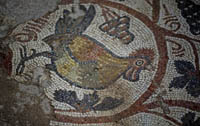Thieves lead authorities to lost Byzantine church
 This past September the Israeli Antiquities Authority noticed some suspicious activity in the Judean Hills southwest of Jerusalem. A sting operation managed to catch thieves digging into a deserted mound at Hirbet Madras. When archeologists arrived a few months later they discovered the remains of a richly decorated basilica complete with 8 marble columns imported from the imperial quarries in Turkey and stunningly preserved mosaic floors with images of lions, foxes, fish, and peacocks (http://yhoo.it/hIANCU). The building dates from the early sixth century- right in the middle of Emperor Anastasius I’s reign- but its location presented a bit of a mystery. Why would a Byzantine emperor lavish so much attention to a relatively remote spot in the Judean wilderness?
This past September the Israeli Antiquities Authority noticed some suspicious activity in the Judean Hills southwest of Jerusalem. A sting operation managed to catch thieves digging into a deserted mound at Hirbet Madras. When archeologists arrived a few months later they discovered the remains of a richly decorated basilica complete with 8 marble columns imported from the imperial quarries in Turkey and stunningly preserved mosaic floors with images of lions, foxes, fish, and peacocks (http://yhoo.it/hIANCU). The building dates from the early sixth century- right in the middle of Emperor Anastasius I’s reign- but its location presented a bit of a mystery. Why would a Byzantine emperor lavish so much attention to a relatively remote spot in the Judean wilderness?
The answer may be found in the neighboring country of Jordan. There is a famous mosaic map in the town of Madaba which was made around the year 560 AD. It provides a unique snapshot of the Byzantine world at the time as it shows every major Biblical site from Lebanon to Egypt. So what does it show in the rough area of Hirbet Madras? A church dedicated to the Old Testament prophet Zechariah which was believed to house his relics. Of course the map isn’t exactly precise, but when the archeologists dug below the floor of the church they found a much older Jewish complex. A network of tunnels dating back to the Bar Kokhba uprising (132-135 AD) were found along with stone vessels, lamps and pottery from the Second Temple period. Most intriguingly of all there was one ancient chamber connected to the church- a small burial cave.
Nearly a millennium separated the death of Zechariah from the building of the Byzantine shrine, but they at least were convinced that they had found his last resting place. And now thanks to a clumsy group of grave robbers we’ve probably found the lost Church they built to venerate it.
If you want to see it in person, you’re in luck. Israeli archeologists plan to cover up the remains next week to preserve them and then develop a permanent tourist site.